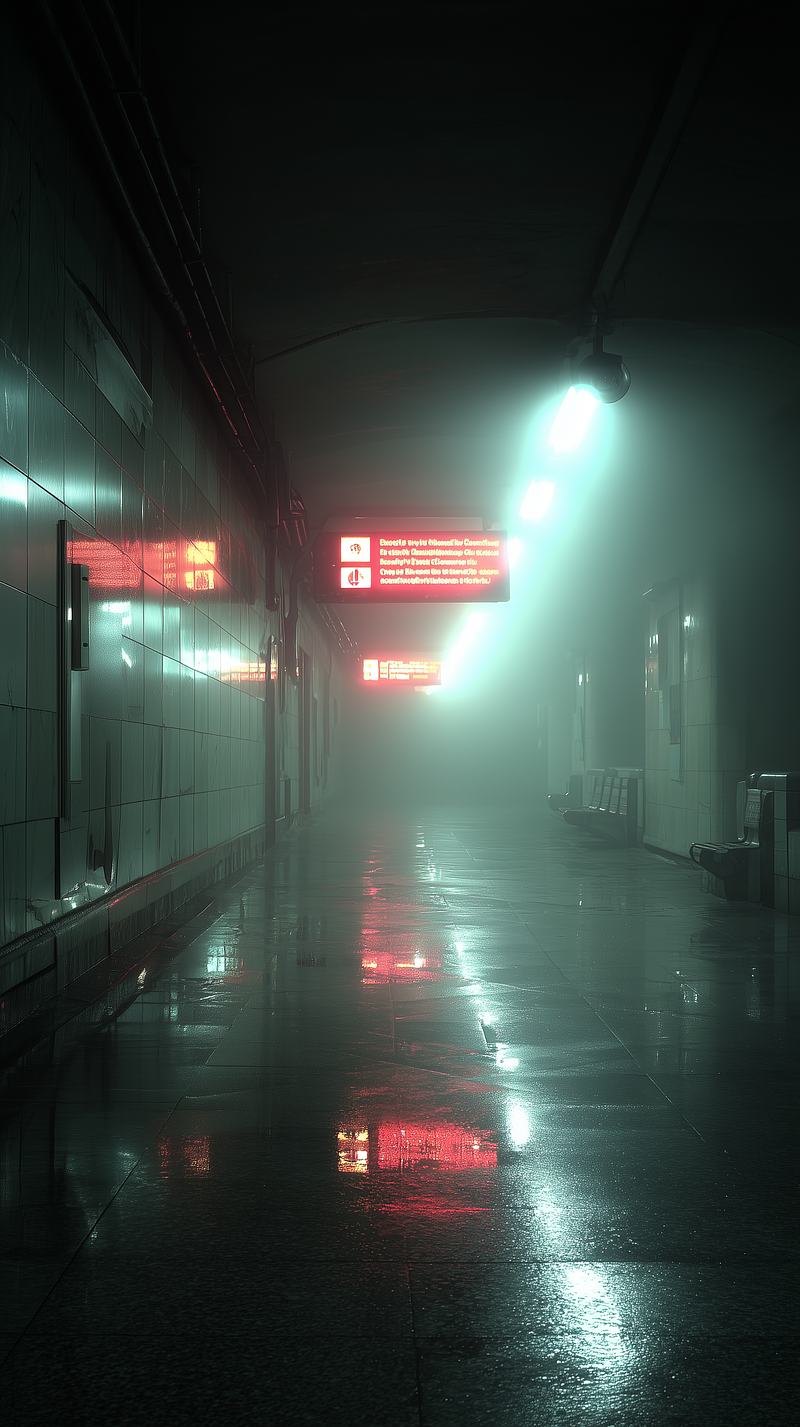


9 months ago
surrealist, Brutalist high Fashion low angle photo of a 24 year old Dutch-Thai female striking model with Hypnotic enchantment expression. Her body is Tight, sculpted lower back with smooth skin and visible muscle definition, toned muscles, abs, small breast, flat chest. She has Fair skin with a translucent quality, often revealing the faint blue of veins. The skin pores and texture are clearly visible and in focus. Her Inverted triangle eyes, Mysterious, midnight blue eyes, framed by long, elegant eyelashes. Her haircut is Buzz cut. Her haircolor is White hair. Her eyebrows are Asymmetrical brows shaped, complementing her delicate facial features. Her outfit is Brutalist facade texture shirt, midriff, Raw edge unfinished hem trousers, She poses in She strikes a pose with arms bent and hands raised to frame her face, creating an engaging and dynamic look.. in the background Concrete sea defense structure, lights Sharp shadows from concrete brise-soleil in the style of Sophie Muller

5 months ago
dynamic, full shot of the Joker character, from the movie "Joker", a Caucasian man, likely in his late 20s or early 30s, with exaggeratedly styled makeup and a vibrant red costume. He's wearing a red, bold, three-piece suit with a yellow vest, a bold style choice that's a key characteristic of the character. The suit has a sharp cut, and appears to be made of a smooth, slightly glossy fabric. Dark reddish-brown leather dress shoes. His arms are outstretched with one fist raised, conveying a sense of triumph or defiance. His posture is dynamic and expressive, showcasing the character's intense persona. The expression is one of powerful triumph, or perhaps manic joy. He's standing in a narrow urban alleyway, a low-angle, wide shot, with high brick buildings lining the sides of the alley, in a gritty urban New York style setting. The background structures show age and wear, with visible brick and metal detailing. The alleyway floor is made up of large, dark, gray-brown paving stones. The lighting is dramatic, with bright, natural light casting shadows in a low-contrast manner, that highlights the intensity of the subject. The overall atmosphere is intensely dramatic and theatrical, with a sense of heightened reality, consistent with the film's style. Detailed makeup, intense expression, and stylish attire are captured with precision and flair, cinematic movie poster style

5 months ago
The Joker, Caucasian male, mid-30s, wearing a classic purple pinstriped suit, orange waistcoat, and teal-spotted cravat. He wears a purple fedora. He is grinning maniacally. He holds a handgun, and is in a dynamic, fast-moving pose, as if in mid-stride, suggesting action and a sense of urgency. The lighting is dramatic, with strong shadows and highlights, showcasing the rich details of the clothing and the character's expression. The background depicts a city street scene with posters and signs. The colors are vivid and bold, with deep purples, vibrant teals, and oranges. The style is comic book art, with a painterly quality and detailed textures on the fabric. A smoky or foggy effect surrounds the Joker, emphasizing his motion and creating a dramatic atmosphere. The perspective is a slightly low-angle shot, focusing on the Joker's dynamic movement, with a medium close-up view. The overall mood is energetic, intense, and slightly menacing, reflective of the character's personality. Ultra detailed, comic book style, highly stylized, cinematic lighting, realistic fabrics
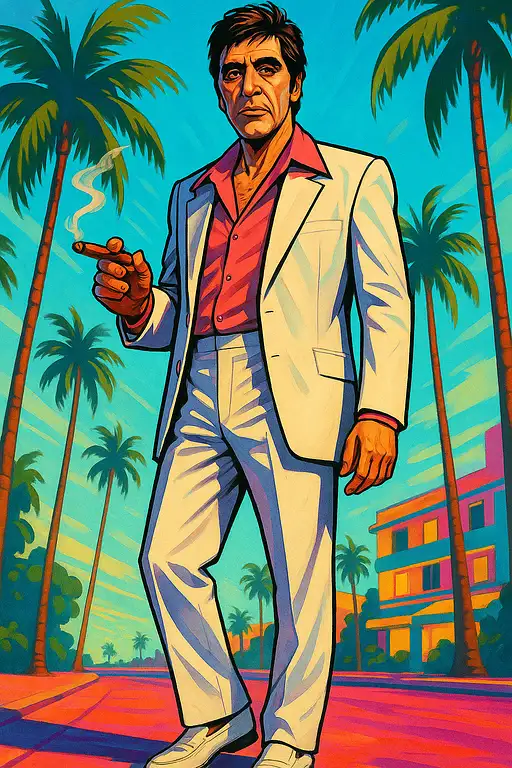
3 months ago
Full-body illustration of Al Pacino in a stylized 1980s Miami setting. He's wearing a pink wide-collar shirt under a white suit, with white loafers. In his right hand, he holds a lit cigar with smoke softly rising. The camera angle is slightly low, emphasizing his presence. The background features tall palm trees, a bright blue sky, and a vibrant atmosphere. The style should mimic the colorful, exaggerated aesthetic of GTA 5 artwork — bold lines, vivid colors, and a dynamic, stylized look
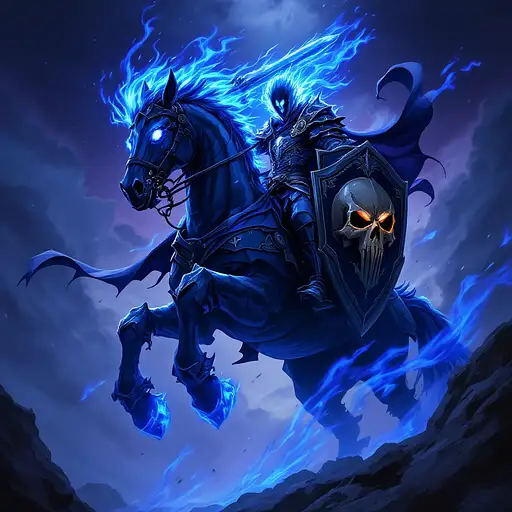
7 months ago
((anime wallpaper Yu-Gi-Oh), whimsical, (absurd resolution)), Masterpiece, highest quality, (extremely detailed Yu-Gi-Oh wallpaper in 8k), (Best Illustration), (superior shadowing), realistic lighting, intricate glow, dark headless horseman on a colossal horse with hooves and eyes of blue-black fire dressed in dark knight's armor with a large sword with a skull hilt and a dark shield with blue fire escaping from his body, full detailed body, fingers and hands meticulously rendered, (((Dynamic battle stance from a low angle))) in a Yu-Gi-Oh Duel Monsters painting style.

2 months ago
liminal underground bus terminal, after-hours, sodium vapor glow, unoccupied, subtle fog, wet floor reflections, hollow ambience, wide-angle 28mm, tripod-stable frame, long exposure hint, tonal separation, soft bloom, realistic texture fidelity, clean geometry, timetables & directional arrows, negative space emphasized, desaturated palette, faint chromatic aberration, filmic grain low, high dynamic range balance, minimal color cast control --ar 9:16 --raw --stylize 300

8 months ago
Epic dark fantasy oil painting capturing the raw, mythological power of Thor, the Norse god of thunder. The setting is a wild, snowy Scandinavian landscape engulfed in a fierce blizzard, with snow whipping across the scene in chaotic gusts. The stormy sky is thick with heavy clouds, nearly obscuring the distant mountains, and cast in deep, moody blues and grays. Thor is seen from a low angle, making him appear larger-than-life and truly god-like, towering over the viewer with an aura of unstoppable strength. His powerful, muscular frame is emphasized by his pose, legs planted firmly in the deep snow as he raises Mjölnir, his legendary battle hammer, high into the turbulent sky. He is fierce and resolute, his hair and fur-lined cloak whipping wildly in the freezing wind. A massive bolt of lightning crashes down from the storm clouds, connecting with Mjölnir and bathing Thor in a blazing, blue-white glow that pierces through the blizzard. The intense light highlights his rugged features and casts dramatic shadows across his face and armor, giving him a godly, otherworldly presence. The lightning arcs around him, crackling with raw energy as snow and ice are blasted into the air from the sheer force. Thor’s attire is inspired by traditional Norse mythology, with a thick fur cloak, leather armor reinforced with metal, and sturdy boots fit for a winter warrior. His gaze is fierce, and his entire posture exudes strength and defiance against the raging storm. The color palette is cold and intense, dominated by icy blues, sharp whites, and deep shadows. The lightning illuminates Thor in a spectral light, creating a sharp contrast against the darkness of the blizzard. Snow swirls violently in every direction, caught in the powerful light, adding dynamic movement and depth to the scene. Every detail is meticulously rendered: the rippling muscles, the coarse texture of Thor’s fur cloak, the chaotic streaks of lightning, and the fierce, swirling snow. The composition conveys the raw, untamed power of the Norse god, capturing the viewer’s attention with the overwhelming force of mythic heroism and natural fury.

9 months ago
surrealism painting 3d scenery, in the middle of the desert, a giant canvas displays a stunningly realistic oil painting of a gorgeous woman taking a shower, the view is from the back, the woman's figure is two-dimensional, with visible brushstrokes and texture, washing her hair under a waterfall, the desert acts as a display for the canvas, the desert is hyper-realistic, Unreal Engine, camera view up, extreme low camera angle, dynamic angle, 8k, wet hair, wet face, bright colors, with subtle cracks and worn edges on the canvas to emphasize the painting illusion.
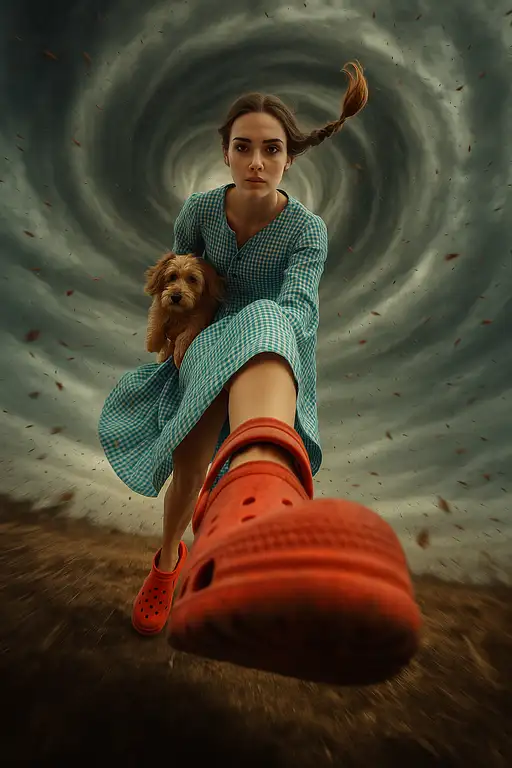
3 months ago
{ "scene": { "setting": "inside a swirling tornado", "mood": "dramatic and surreal", "style": "hyper-realistic, fashion editorial", "lighting": "high contrast with stormy overcast sky", "atmosphere": "intense, with debris flying and motion blur around edges" }, "subject": { "type": "girl", "age": "20", "expression": "focused, intense", "pose": "falling or flying upwards with foot toward camera", "outfit": { "top": "blue gingham dress", "shoes": "bold red Crocs" }, "hair": "braided, swept upward by wind", "accessories": { "animal": "small fluffy dog held under her arm" } }, "camera": { "angle": "extreme wide-angle, low perspective from foot upward", "lens": "ultra wide-angle", "motion": "dynamic motion blur on foot and background debris", "focus": "sharp on girl’s face and dress, blurred background" }, "effects": { "wind": "clothes and hair dramatically lifted", "debris": "leaves and dirt spiraling around", "sky": "dark and stormy with funnel clouds" }, "composition": { "foreground": "large red Croc in extreme perspective", "background": "tornado spiral and flying particles" } }

6 months ago
A full-body fantasy style, editorial portrait, full body view, head to toe, of a woman practicing a cow/cat yoga pose in a sun-dappled jungle clearing. She seems to glows softly in the golden hour light filtering through thick foliage. She wears ceremonial jewelry, feathers, and a nature-inspired outfit with gemstone details. Captured from a low diagonal side view, she stretches with focus and grace, exuding strength and calm. The setting is rendered in ultra-detailed, high-gloss fantasy style with vibrant colors, soft cinematic lighting, and richly textured jungle elements — evoking a serene moment of harmony between body and nature. angle is from a dynamic rear angle, she's looking back over her shoulder with intensity. Camera: 35 mm prime, f/2.2, mid‑shallow DoF, low‑angle framing. Film: digital RAW with Ektachrome teal‑and‑gold color grade, 8% fine grain. Lighting: direct midday sun 5600K, reflections; crisp specular highlights. Textures: hyper-realistic, hyper detailed, natural Vibe: confident, adventurous, sporty glamour.

6 months ago
A hyperrealistic, full-body, high-quality, detailed image of a young, approximately 20-year-old brunette woman with delicate, sensitive facial features and a very athletic build, reflecting her elite soldier status as a futuristic warrior in a technologically advanced civilization. She is adorned in a spectacular, highly reflective metallic suit, emphasizing her sleek physique and power. The suit's metallic surface catches the light, creating captivating highlights and reflections, capturing her strength and agility. She carries futuristic weaponry, including a plasma rifle and energy blades strapped to her back. The background shows a hyperrealistic, futuristic cityscape in ruins, with remnants of battle, showcasing advanced technology. The scene is captured with a low-angle view and dynamic lighting, accentuating the intensity of the battle and her unwavering resolve. She is covered in dust from the explosions and gunfire, but still fighting, with a determined expression, further emphasizing her commanding presence. The composition and lighting work together to create a powerful and evocative image of a futuristic warrior in the midst of battle, showcasing her strength and resilience in a technologically advanced world. The image is rendered in a photorealistic style, with a focus on capturing the intricate details of the futuristic armor, the weaponry, and the ravaged cityscape.

5 months ago
Flux_style_vibrant. Hyper-detailed, dynamic full body shot, low angle view. African American woman with striking cornrows. Bold purple graphic makeup. Sharp, glossy purple nails. Wearing a translucent, flowing sheer purple dress; no undergarments visible. Holding a textured purple handbag. Abstract, softly blurred background suggestive of an artistic locale. Intense color focus, dynamic lighting highlighting the purple spectrum and her empowered silhouette.

5 months ago
Create a meticulously staged cinematic scene with rigid symmetry and frontal, low-angle framing, emphasizing a diagonal composition (45-degree tilt) where all elements align along a single dynamic axis. Color Grading: 60% Dominant: Soft, powdery pastel pinks (Pantone 12-1109 TPX "Marshmallow") saturating the sky, snow, and TV casing. 30% Secondary: Frosted teal blues (HEX #6ECEDA) in the glacial lake, aurora, and TV screen static. 10% Accent: Mustard-yellow (Pantone 15-0950 TPX "Golden Glow") in the aurora streaks, wool tufts, and corroded metal knobs. TV Design: A 1950s Bakelite TV (matte eggshell plastic with hairline cracks) tilted diagonally (top-left corner at 10 o’clock, bottom-right submerged at 4 o’clock). Crack: A jagged diagonal fissure (2cm wide) splits the screen from top-left to bottom-right, leaking viscous, neon-bright color bar pigment (RGB values: pink #FF9EB5, teal #5FDAC3, gold #FFD700) that pools into the water below. Materials: Body: Faux-weathered plastic with chipped edges revealing rusted steel underlayers. Details: Three rotary knobs (tarnished brass, 4cm diameter) labeled "VOL," "TUNE," "POWER." Cables: Braided wool cords (undyed cream yarn, 3cm thickness) coiled around the TV’s base, fraying at the ends. Screen Imagery: Static Overlay: A 1953 RCA-style color bar test pattern (8 vertical bands) glitching every 2 seconds, causing the teal and pink bars to "melt" downward into liquid the word "Imagen-4" glitches on the screen Underlying Image: A faint, glowing topographical map (golden-yellow lines on indigo) dissolves into water that cascades from the screen’s crack, merging with the glacial lake. Environment: Glacial Lake: Semi-frozen water (translucent teal, 70% opacity) with jagged ice shards (20cm height) encircling the TV. Snowfall: Heavy, dense snowflakes (1cm diameter) falling at 45 degrees, accumulating on the TV’s top-left corner. Aurora Borealis: Three parallel bands (pink #FFB3D1, teal #7FE5E5, gold #FFE44D) in smooth sine waves, 15° tilt, 80% opacity. Sky: Ultra-high-contrast starfield (ISO 51200 noise pattern) with 2,000 visible stars (randomized 2-4px white dots). Lighting & Effects: Key Light: A frontal, low-orange sodium vapor lamp (3200K) casting sharp diagonal shadows (20° angle) from the TV onto the ice. Bloom: Halation around the aurora and screen, radius 15px, intensity 70%. Textures: Film Grain: 35mm Kodak Vision3 250D overlay (gritty, high-detail). Lens Defects: Two hairline scratches (1px width) at 15° and 75° angles, plus hexagonal lens flare (60% opacity) from the aurora. Physics & Motion: Water: Viscous fluid dynamics—the leaking color bars swirl in 5cm eddies, blending with the glacial lake. Wool: Submerged yarn floats upward in 10cm tufts, swaying at 0.5Hz frequency. Result: A hyper-detailed, reference-free scene that implicitly channels Wes Anderson’s aesthetic through obsessive symmetry, retro-kitsch materials, and a strict 60/30/10 pastel hierarchy—no director named, all style embedded in granular technical specs.

5 months ago
"Create a meticulously staged cinematic scene with rigid symmetry and frontal, low-angle framing, emphasizing a diagonal composition (45-degree tilt) where all elements align along a single dynamic axis. Color Grading: 60% Dominant: Soft, powdery pastel pinks (Pantone 12-1109 TPX "Marshmallow") saturating the sky, snow, and TV casing. 30% Secondary: Frosted teal blues (HEX #6ECEDA) in the glacial lake, aurora, and TV screen static. 10% Accent: Mustard-yellow (Pantone 15-0950 TPX "Golden Glow") in the aurora streaks, wool tufts, and corroded metal knobs. TV Design: A 1950s Bakelite TV (matte eggshell plastic with hairline cracks) tilted diagonally (top-left corner at 10 o’clock, bottom-right submerged at 4 o’clock). Crack: A jagged diagonal fissure (2cm wide) splits the screen from top-left to bottom-right, leaking viscous, neon-bright color bar pigment (RGB values: pink #FF9EB5, teal #5FDAC3, gold #FFD700) that pools into the water below. Materials: Body: Faux-weathered plastic with chipped edges revealing rusted steel underlayers. Details: Three rotary knobs (tarnished brass, 4cm diameter) labeled "VOL," "TUNE," "POWER." Cables: Braided wool cords (undyed cream yarn, 3cm thickness) coiled around the TV’s base, fraying at the ends. Screen Imagery: Static Overlay: A 1953 RCA-style color bar test pattern (8 vertical bands) glitching every 2 seconds, causing the teal and pink bars to "melt" downward into liquid with the word "Prompthero" barely visible on it. Underlying Image: A faint, glowing topographical map (golden-yellow lines on indigo) dissolves into water that cascades from the screen’s crack, merging with the glacial lake. Environment: Glacial Lake: Semi-frozen water (translucent teal, 70% opacity) with jagged ice shards (20cm height) encircling the TV. Snowfall: Heavy, dense snowflakes (1cm diameter) falling at 45 degrees, accumulating on the TV’s top-left corner. Aurora Borealis: Three parallel bands (pink #FFB3D1, teal #7FE5E5, gold #FFE44D) in smooth sine waves, 15° tilt, 80% opacity. Sky: Ultra-high-contrast starfield (ISO 51200 noise pattern) with 2,000 visible stars (randomized 2-4px white dots). Lighting & Effects: Key Light: A frontal, low-orange sodium vapor lamp (3200K) casting sharp diagonal shadows (20° angle) from the TV onto the ice. Bloom: Halation around the aurora and screen, radius 15px, intensity 70%. Textures: Film Grain: 35mm Kodak Vision3 250D overlay (gritty, high-detail). Lens Defects: Two hairline scratches (1px width) at 15° and 75° angles, plus hexagonal lens flare (60% opacity) from the aurora. Physics & Motion: Water: Viscous fluid dynamics—the leaking color bars swirl in 5cm eddies, blending with the glacial lake. Wool: Submerged yarn floats upward in 10cm tufts, swaying at 0.5Hz frequency. Result: A hyper-detailed, reference-free scene that implicitly channels Wes Anderson’s aesthetic through obsessive symmetry, retro-kitsch materials, and a strict 60/30/10 pastel hierarchy—no director named, all style embedded in granular technical specs.

5 months ago
dynamic, full shot of the Joker character, from the movie "Joker", a Caucasian man, likely in his late 20s or early 30s, with exaggeratedly styled makeup and a vibrant red costume. He's wearing a red, bold, three-piece suit with a yellow vest, a bold style choice that's a key characteristic of the character. The suit has a sharp cut, and appears to be made of a smooth, slightly glossy fabric. Dark reddish-brown leather dress shoes. His arms are outstretched with one fist raised, conveying a sense of triumph or defiance. His posture is dynamic and expressive, showcasing the character's intense persona. The expression is one of powerful triumph, or perhaps manic joy. He's standing in a narrow urban alleyway, a low-angle, wide shot, with high brick buildings lining the sides of the alley, in a gritty urban New York style setting. The background structures show age and wear, with visible brick and metal detailing. The alleyway floor is made up of large, dark, gray-brown paving stones. The lighting is dramatic, with bright, natural light casting shadows in a low-contrast manner, that highlights the intensity of the subject. The overall atmosphere is intensely dramatic and theatrical, with a sense of heightened reality, consistent with the film's style. Detailed makeup, intense expression, and stylish attire are captured with precision and flair, cinematic movie poster style

7 months ago
8K modern portrait, (mixed-race girl, age 8:1.4), (top-down, extremely high angle view:1.7), (head angled 45 degrees back:1.6), (large glistening eyes gazing upward:1.8), (joking dimpled smile:1.7), slim, straight black hair, (0.1mm razor-sharp strands:1.6), (shine like glass: 1.5), (disconnected micro-flyaways:1.3), (weightless motion frozen in motion:1.4), (Contrast inspired by Ansel Adams:1.6), (real blacks #000000:1.5), (whites crisp #FFFFFF:1.4), (12-stop dynamic range: 1.5), (silky midtones: 1.6 with no banding), (upper left directional softbox:1.7), (hard Rembrandt triangle beneath right eye:1.6), (jawline rim light: 1.5), (neck shadow gradient:1.4), (simulation of film grain:1.5), (Grain structure of Ilford HP5 Plus 400:1.4), (created in D-76 1:1:1.3), (subtle toning effect of selenium:1.2), (Hasselblad 907X + 80mm f/2.8:1.6), (photo taken with a Kodak T-Max 100:1.5), (low-key lighting ratio 1:8:1.4), (8K drum scan: 1.7), (Charcoal rendering of the mustard jacket: 1.5), (white floor is yellow:1.5)
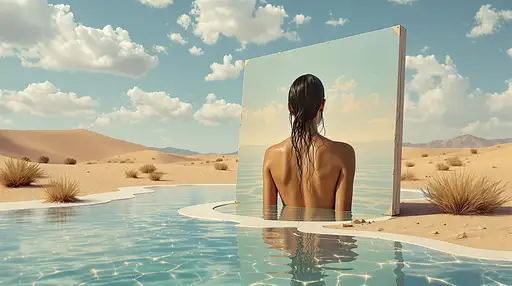
9 months ago
surrealism painting 3d scenery, in the middle of the desert, a giant canvas in the right side displays a stunningly realistic oil painting of a gorgeous woman batig in a waterpool the view is from the back, the woman's figure is two-dimensional, with visible brushstrokes and texture, the desert acts as a display for the canvas, the desert is hyper-realistic, Unreal Engine, camera view up, extreme low camera angle, dynamic angle, 8k, wet hair, wet face, bright colors, with subtle cracks and worn edges on the canvas to emphasize the painting illusion.
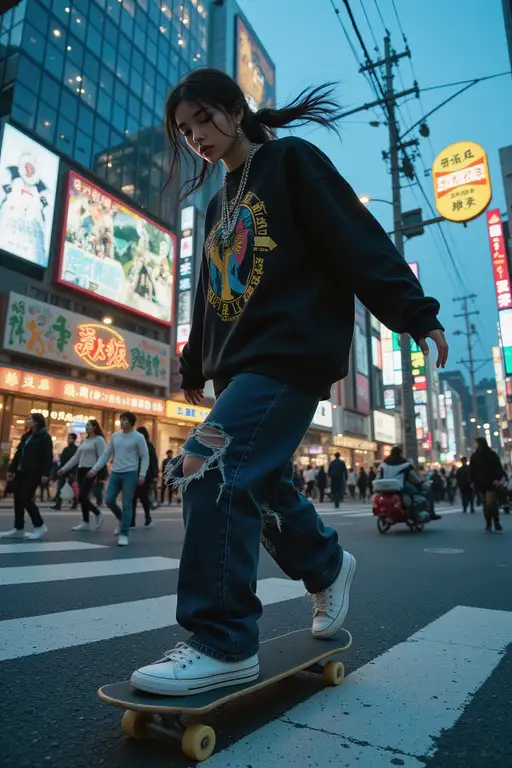
3 months ago
A dynamic, wide-angle, low-angle action photograph of a stylish young Japanese woman skateboarding through the iconic Shibuya Crossing in Tokyo at dusk. Her long dreadlocks are flying as she moves. She wears an oversized black graphic sweatshirt, heavily ripped baggy jeans, and classic skate shoes, accessorized with layers of silver chain necklaces. The background is a blur of motion, neon lights, and the vibrant graffiti of the HachikÅ statue wall. The photo captures a sense of speed with slight motion blur on the pavement. Cinematic, high-contrast lighting from the city signs and fading daylight. Ultra-realistic, gritty, and capturing the energetic spirit of Tokyo street culture.

6 months ago
A hyper-realistic cinematic poster-style image of a large white egg with two small chicken legs bursting out through a cracked hole at the bottom, sprinting directly toward the camera. The egg is mid-motion, with dramatic motion blur behind its legs and shell, emphasizing speed and urgency. Straw and dust trail behind as it escapes from a nest in the background. Other intact eggs lie still in the nest. A shocked mother hen is partially visible in the distance, out of focus. Low-angle dynamic camera perspective, warm golden-hour lighting, intense depth of field, and vivid details in feathers, straw, and shell cracks. Epic and humorous composition, designed to look like a movie poster.

5 months ago
A dynamic action shot, captured from a low angle, of a woman with long, dark, flowing hair, wearing a short red dress, a red leather corset, and black combat boots (Springerstiefel), caught in a forest clearing now engulfed by swirling, aggressive dust that seems to attack her. The scene is bathed in dramatic lighting, highlighting the chaotic dust and her determined struggle. Her movements are fluid yet desperate, expertly wielding two daggers to fight off and cut through the whirling dust. Motion blur emphasizes the dust and her quick movements. Her face reflects a fierce determination mixed with the strain of battling this elemental force, a reflection of the chaos and her resilience. The surrounding forest shows signs of battle and the impact of the swirling dust, including broken branches and discolored foliage. The overall tone is one of intense struggle against an overwhelming, almost supernatural threat, creating a sense of suspense and danger
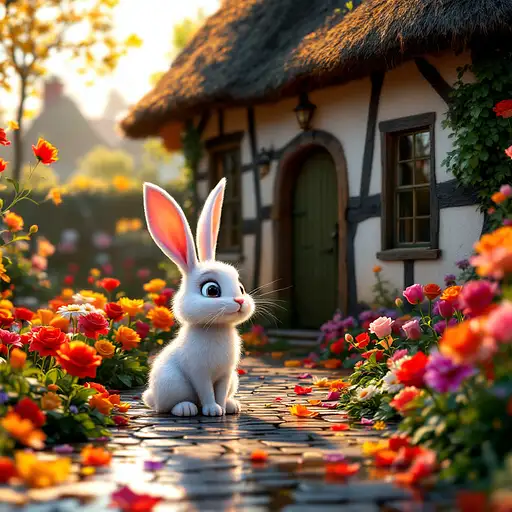
8 months ago
A whimsical 3D animated scene depicting a quaint cottage, rendered in a photorealistic style with dynamic camera angles. The cottage, a charming two-story structure with half-timbered walls and a thatched roof, is nestled amidst a vibrant, overflowing garden bursting with colorful blooms – roses, tulips, and daisies in a riot of reds, oranges, yellows, and purples. Realistic lighting and shadows create depth, enhancing the three-dimensional space. The textures are exquisitely detailed: rough-hewn wood, soft petals, and the velvety texture of the rabbit's fur. A large, white rabbit with exceptionally long ears and luminous, expressive eyes sits poised before the cottage door, its fur gleaming softly in the sunlight. The rabbit's posture conveys a gentle curiosity, its head tilted slightly, its big eyes focused intently. The scene is bathed in warm, inviting light, casting long shadows that accentuate the cottage's architecture and the garden's lushness. Reflections shimmer on the wet cobblestones of the path leading to the cottage. The overall atmosphere is one of idyllic charm and peaceful tranquility, evoking a sense of wonder and gentle fantasy. The style blends realistic rendering with animation-inspired fluidity and vibrancy, reminiscent of Pixar's attention to detail. The camera perspective is a slightly low angle, emphasizing the cottage's height and the rabbit's prominence.
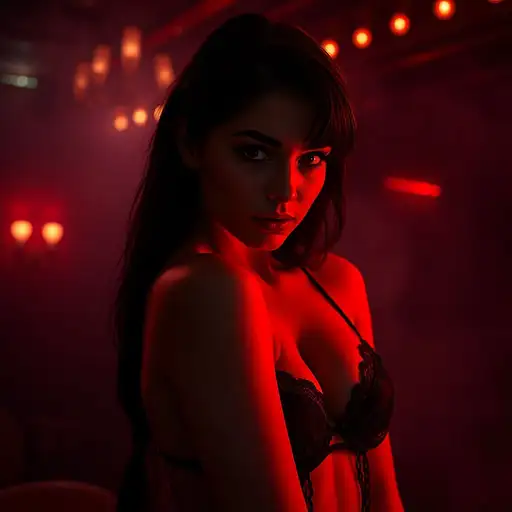
8 months ago
RAW photo, low key, cinematic composition, Moulin Rouge, cabaret style, burlesque, photograph of a gorgeous young girl, slender toned body, at a burlesque club, highly detailed, sultry pose, smoky room, dark lit, low key, alluring, seductive, muted color tones, black and dark with red color popping out, rim light, lingerie, soft cinematic light, (perfect anatomy), (detailed eyebrows, beautiful eyes, realistic skin, detailed face:1. 3), (focus on face, looking at viewer:1. 1), dynamic pose, dynamic angle, photorealistic, photo realism, 8K UHD, absurdres, shot by professional DSLR camera, F1. 4, 1/800s, ISO 100, sharp focus, depth of field, rule of third
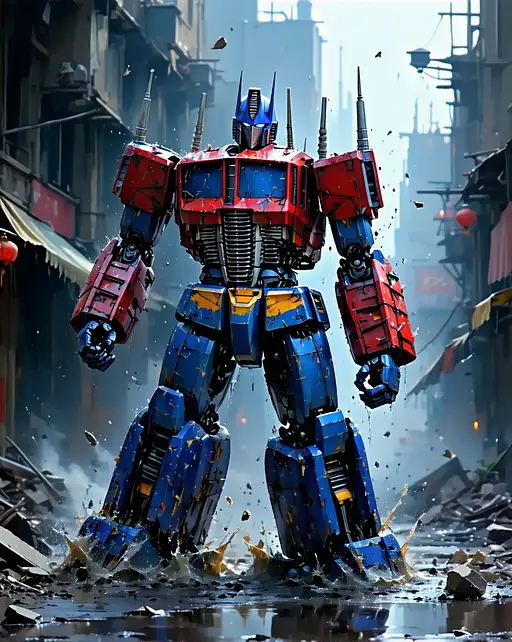
4 months ago
painting style, urbanpunk, low angle shot, a cybernetic samurai Optimus Prime in a post-apocalyptic setting, attacking me, body dynamic epic action pose, bladerunner city street ruined background with relfections in puddles, highly detailed, hyper-realistic masterpiece, dramatic cinematic lighting, tons of flying debris around him, epic and dynamic composition, intricate details, modifier=CarnageStyle, color=blood_red, intensity=1.6
